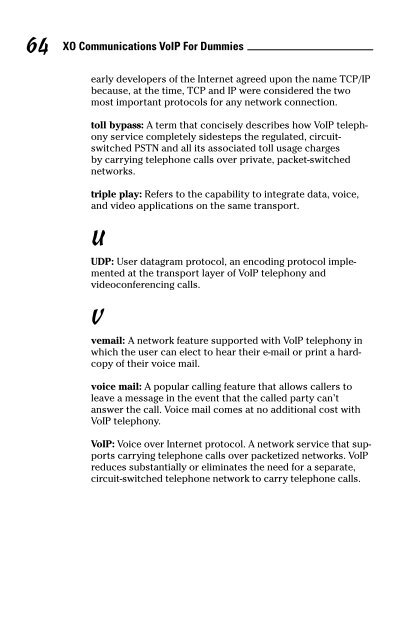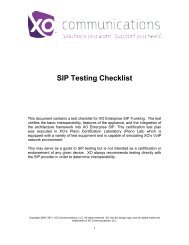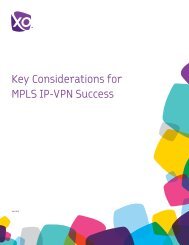VoIP for Dummies Book - XO Communications
VoIP for Dummies Book - XO Communications
VoIP for Dummies Book - XO Communications
You also want an ePaper? Increase the reach of your titles
YUMPU automatically turns print PDFs into web optimized ePapers that Google loves.
64<br />
<strong>XO</strong> <strong>Communications</strong> <strong>VoIP</strong> For <strong>Dummies</strong><br />
early developers of the Internet agreed upon the name TCP/IP<br />
because, at the time, TCP and IP were considered the two<br />
most important protocols <strong>for</strong> any network connection.<br />
toll bypass: A term that concisely describes how <strong>VoIP</strong> telephony<br />
service completely sidesteps the regulated, circuitswitched<br />
PSTN and all its associated toll usage charges<br />
by carrying telephone calls over private, packet-switched<br />
networks.<br />
triple play: Refers to the capability to integrate data, voice,<br />
and video applications on the same transport.<br />
U<br />
UDP: User datagram protocol, an encoding protocol implemented<br />
at the transport layer of <strong>VoIP</strong> telephony and<br />
videoconferencing calls.<br />
V<br />
vemail: A network feature supported with <strong>VoIP</strong> telephony in<br />
which the user can elect to hear their e-mail or print a hardcopy<br />
of their voice mail.<br />
voice mail: A popular calling feature that allows callers to<br />
leave a message in the event that the called party can’t<br />
answer the call. Voice mail comes at no additional cost with<br />
<strong>VoIP</strong> telephony.<br />
<strong>VoIP</strong>: Voice over Internet protocol. A network service that supports<br />
carrying telephone calls over packetized networks. <strong>VoIP</strong><br />
reduces substantially or eliminates the need <strong>for</strong> a separate,<br />
circuit-switched telephone network to carry telephone calls.






